When two worlds meet
We all recognise the situation when we try to transfer the way of working from a traditional way to a more agile or DevOps way. Some people like this new way, while others don’t. Some people cooperate immediately, while others are still thinking that this new way is not going to work.
In this article I am going to explain what is happening in a team when two worlds meet. How ‘old’ ways of working are mixing with ‘new’ ways of working, and how a business simulation is an effective instrument to motivate people to start their journey into the new way of working and avoid wasting time, effort and money.
How a ‘way of working’ is following a certain path
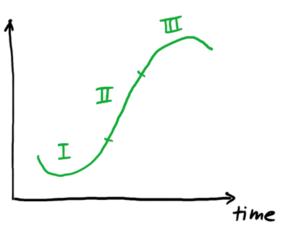 Imagine the current way of working in an IT department or team. All behaviours, symbols, communication, roles, rules and processes once started in a very unstable way. We call this stage I. People are searching for a ‘new’ way of working and are experimenting. Some like it, some don’t. After this stage the team found the ‘right’ way of working and the team comes into a flow, stage II. The team builds routine and most of the rules and processes are automated. After some time, we reach stage III. Some of the processes, rules or roles are no longer working. The flow is becoming unstable and the ‘way of working’ is coming to an end.
Imagine the current way of working in an IT department or team. All behaviours, symbols, communication, roles, rules and processes once started in a very unstable way. We call this stage I. People are searching for a ‘new’ way of working and are experimenting. Some like it, some don’t. After this stage the team found the ‘right’ way of working and the team comes into a flow, stage II. The team builds routine and most of the rules and processes are automated. After some time, we reach stage III. Some of the processes, rules or roles are no longer working. The flow is becoming unstable and the ‘way of working’ is coming to an end.
In fact this is happening at this moment in many IT organisations. We see the ITSM processes, and the Agile development processes being influenced by a DevOps way of working. It looks like the current way of working is coming to an end and being replaced by a ‘new’ one.
If one way of working is coming to an end, there will be a new way of working with new rules, processes, roles, dynamics et cetera. This new way will follow a similar kind of path. This will give the following visualisation.
What if ‘old’ and ‘new’ come together?
The ‘old’ way and the ‘new’ way will come together. In this area A, the two worlds will meet and we will observe a very interesting set of dynamics.
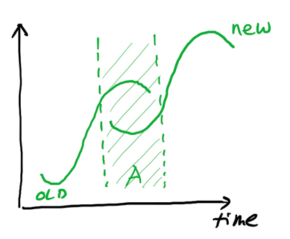 We observe people that are starting to experiment with this ‘new’ way of working. They are enthusiastic, they start new initiatives and are called the early adopters. But, we also see people that still do not believe that this is going to work. They show resistance against this way of working, are a bit negative or simply need more time to be convinced.
We observe people that are starting to experiment with this ‘new’ way of working. They are enthusiastic, they start new initiatives and are called the early adopters. But, we also see people that still do not believe that this is going to work. They show resistance against this way of working, are a bit negative or simply need more time to be convinced.
If we look a bit closer to this area A, we can identify two elements that are important to investigate. We can observe people that are DOING and THINKING. We observe people that start stand ups and KanBans. We can observe people that start to organise retrospective sessions. They are very busy experimenting with the ‘new’ way of working. But on the other hand, we see people that are still trying to keep the ‘old’ ways of working. They still organise traditional meetings, they don’t work in teams, they circumvent or ignore new roles and responsibilities and do not follow new processes or use new tools.
We also see that some people are discussing the new way of working. They are bringing in new ideas that fit the new way. They show open minds and are mentally moving from the old way into the new way. They see opportunities and are positive. On the other hand, we see people who are believing that the old way was much better. They are more negative and are not open minded.
4 types of people
In fact what we get is a mix of 4 types of people.
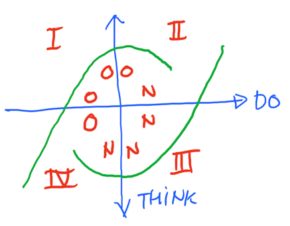
Type I – These people are thinking and doing old. They still don’t know if this new way of working is going to work. Some people are very negative and show resistance, some others are still positive but need more time or evidence.
Type II – These people are thinking old but, since the new way of working is already ‘implemented’ they have to do new. They have to participate in stand ups and have to visualise the work. They have no choice. This group has to make a decision what they are going to do. The longer they wait the more they become isolated.
Type III – These people are on board. They are thinking and doing new. They are positive, they develop new skills and the way of working becomes their ‘this is how we do it’.
Type IV – These people are the early adaptors. They are starting the new initiatives and are experimenting. They are the front-runners that are ‘constructing’ and championing the new way of working.
Exercise
Now take some time and analyse your own team and plot your employees into those four quadrants.
Our two challenges during a transformation and how simulations can help
During our transformation from old to new, we have two big challenges.
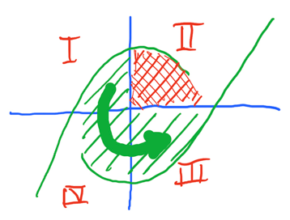 Challenge 1 – Get our people into QIII. We’d like to have all people on board. No resistance, no negative attitudes and a smooth transition. But, we all know this is just a dream. If we have some people in QIV, we can benefit from it. We can assign these people to some special tasks. We can ask them to form a first squad and start to support a first value stream. We can ask them to become Agile coach’s to support other teams. This way we can show others the right behaviours and motivate people to do the same.
Challenge 1 – Get our people into QIII. We’d like to have all people on board. No resistance, no negative attitudes and a smooth transition. But, we all know this is just a dream. If we have some people in QIV, we can benefit from it. We can assign these people to some special tasks. We can ask them to form a first squad and start to support a first value stream. We can ask them to become Agile coach’s to support other teams. This way we can show others the right behaviours and motivate people to do the same.
Challenge 2 – Avoid people that stay in QI or even worse??? who move from QI to QII. This is a dangerous situation. People that stay in QI can start to influence other people negatively by telling others that ‘the old ways were much better!’ or ‘give it a few months it will go away…’. People that shift into QII can cause other issues. They will require a lot of management attention and can demotivate other team members. It is sometimes necessary to let them go.
Paradigm Shift using simulations
One way of dealing with those two challenges is what we call the Paradigm Shift. This is an intervention to give people a fair chance to experience and explore the new way of working to build up their own opinion about it. In fact we let them explore and experiment with ‘doing’ and ‘thinking’ in the new way in a safe and realist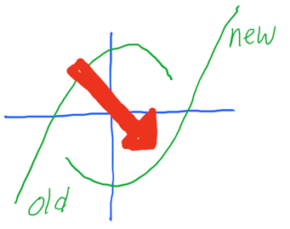 ic environment.
ic environment.
A simulation is a powerful instrument to simulate this new way of working and let a group of people experience what it means to them. During the simulation we explore with the team the following questions:
- How did you experience this way of working?
- What did you like about it?
- What did you dislike?
- What conditions in your current way of working are blocking this new way of working?
- How could we solve this?
- When would this way of working work for you?
- What has to be changed?
To make this session effective keep the following things in mind:
- Design the setup and roles of the simulation as close as possible to the new way of working. People have to recognise what it means for their current way of working and they must have a realistic idea about the new way of working.
- Don’t push people in the new way of working. Give them space to change processes or to experiment with other ways of working.
- Also explore negative feedback from the team. Investigate, explore, challenge them. Remember resistance is not always caused by negativism. It can also come from a fear of losing something, or fear for the unexpected and the unknown
- Use techniques to challenge people to think out of the box. Think about questions like: “What would you do if you were the boss”? Or “What would you change if you had a magic wand”?
- Be clear about the goals of the session and what the rules of the ‘game’ are.
- Be clear about what we are going to do after this session and be concrete about when and who.
- Make sure you show full commitment to apply the outcome of the session. Remember you can only make it worse if you don’t follow up. People will no longer trust you in any new change initiative.
Why does a paradigm shift help?
People will have a fair chance to experience the new way of working. Some of them could have a totally different idea about the new way then others. By ‘playing’ the new way they are better able to understand what it is. On the other hand, they can also be more negative. This is what happened in one of my sessions.
I ran a simulation with a team. At one stake one of the participants said:
“This is never going to work”!
I asked the team if more people had the same feeling. A few more felt the same way.
“What is it, that you think is not going to work”? I asked.
These were a few of the answers:
“Our management will never agree on buying a tool”
“We don’t have dedicated process managers like we do in this game”
“This is an ideal setting, in this game the customer knows the priorities”
I wrote them down and asked the team if those items were the things they experienced in their own day to day work? Then I asked the next question:
“Do you believe that the new way of working will work if those items were solved”?
In the simulation those items were success factors. Most of the team members were positive.
I took it one step further and asked:
“Which of those items would you want to solve first”?
The team agreed on the role of the process managers.
Next we start to discuss what we had to do to convince ‘management’ to assign those roles in the team. A long list of actions came on the board. But also some reactions of people who did not believe that this was ever going to work. At the end of the session we had an action plan and I asked who of the participants would like to join me during the debriefing of the session with the IT Manager.
Two of them joined the debriefing and explained to their manager what happened during the simulation and how they experienced this new way of working.
I spoke to the IT Manager a few weeks after the session and he told me that he assigned an Incident Manager role in the team and that he saw people experimenting with it.
This example shows how a small step can be taken if you let people experience the new way of working during a simulation and how this can lead to a small move from Q1 to Q4. If you do this with many other new ways of ‘behaving’, it can really help create buy-in, empower teams to change and help address resistance, increasing the chance of success for your transformation.
Conclusion
Where two worlds meet, we have a mix of 4 types of people in terms of ‘doing’ and ‘thinking’. Our challenge is to get our teams into Q4 and Q3 to bring the transformation into a flow and stimulate and develop the new way of working. We also want to avoid people being left in Q1 and Q2 for too long. They will cost us energy, time and money. A paradigm shift using simulations is a very powerful way for helping teams to explore the new way of working in a realistic and safe way. They can make up their own mind, and by exploring their feelings and thoughts, we can work on identifying and removing the barriers or bottlenecks so that they feel more comfortable in taking steps into Q4 and Q3.
